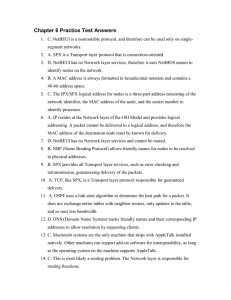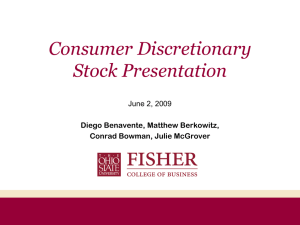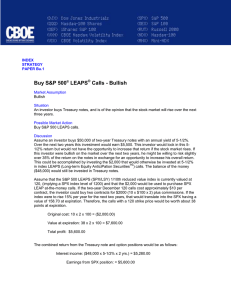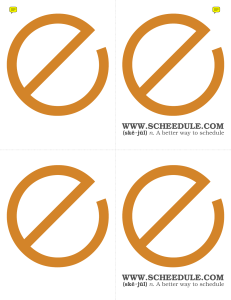CBOE Strategy Benchmark Indexes
advertisement
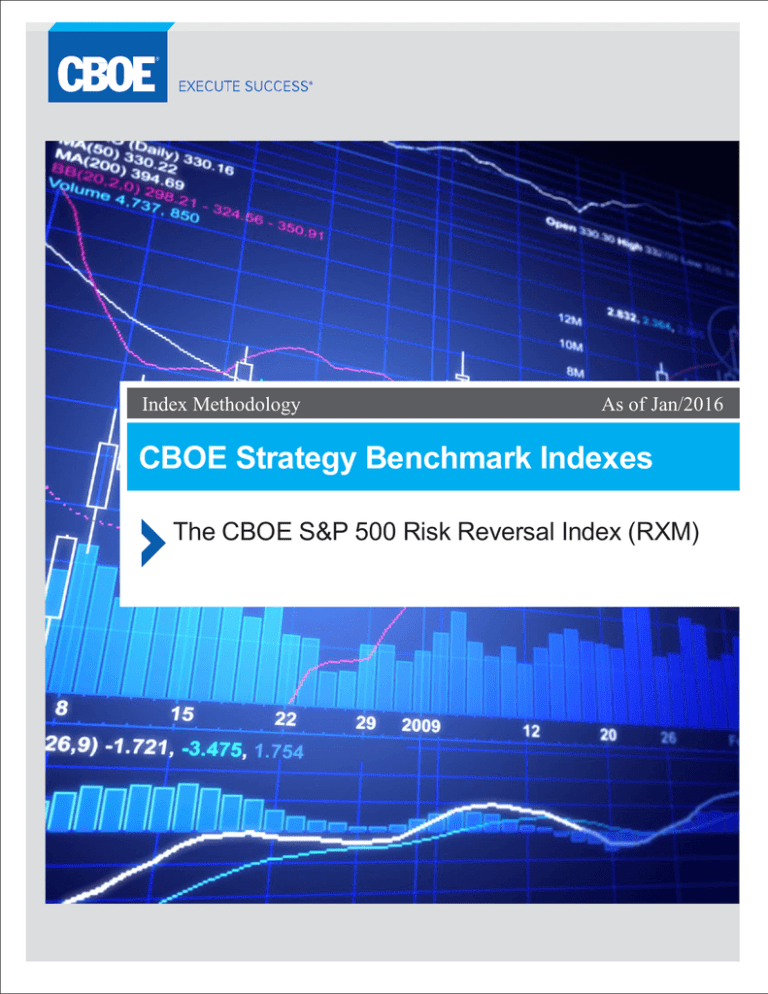
Index Methodology As of Jan/2016 CBOE Strategy Benchmark Indexes The CBOE S&P 500 Risk Reversal Index (RXM) THE CBOE S&P 500 Risk Reversal Index (RXM) Introduction: The CBOE S&P 500 Risk Reversal Index (RXMSM Index) is a benchmark index designed to track the performance of a hypothetical risk reversal strategy that: (1) buys a rolling out-of-the-money (delta ≈ 0.25) monthly SPX Call option; (2) sells a rolling out-of-the-money (delta ≈ - 0.25) monthly SPX Put option; and (3) holds a rolling money market account invested in one-month Treasury bills to cover the liability from the short SPX Put option position. Index Design: On June 20, 1986, the initial roll date of the RXM Index, one unit of an Out-of-the-Money monthly SPX Call option is purchased. The SPX Call option selected is the one with a delta closest to +0.25. Simultaneously, one unit of an Outof-the-Money monthly SPX Put option (the one with a delta closest to - 0.25) is written with a money market account invested in one-month Treasury bills held to cover its liability. All inputs used in the delta calculation using the Black formula should be the last available values before 11:00 am ET. The premiums collected from writing the SPX Put option or paid out for the call option are the volume weighted average trade price between 11:30 am and 12:00 pm ET (VWAP). CBOE calculates the VWAP in two steps: first, CBOE excludes trades in the new SPX option between 11:30 am and 12:00 pm ET that are identified as having been executed as part of a “spread”; and second, CBOE calculates the weighted average of all remaining transaction prices of the new SPX option between 11:30 am and 12:00 pm ET, with weights equal to the fraction of total non-spread volume transacted at each price during this period. If there is no trade in the SPX Put option during the VWAP period, the last bid quote for the SPX Put option before 12:00 pm ET is used. If there is no trade in the SPX Call option during the VWAP period, the last ask quote for the SPX Call option before 12:00 pm ET is used. To cover the liability from the short position of the SPX Put option, $K cash is invested into a money market account, where K is the strike of the Put option just written. The money market account will accumulate interest at the one-month T-bill rate. Typically, on the third Friday (Roll Day) of every month since the initial roll date, the old options settle at 9:30 am ET against the Special Opening Quotation of the SPX Index (SOQ). The old money market account is liquidated at the same time. A new + 0.25 delta monthly SPX Call option and a new – 0.25 delta monthly SPX Put option will be selected at 11:00 am ET. The selecting of strikes follows the same rule as the initial roll date. The premiums of the SPX Call and Put options are the VWAP between 11:30 am and 12:00 pm ET, or the last bid (ask) quote of the applicable option before 12:00 pm ET if there are no trades in the SPX Put (Call) option during the VWAP period. A money market account is set aside as collateral for the new short SPX Put option position to cover the liability. Index Calculation: The RXM Index value is calculated by CBOE in real-time, every 15 seconds. On each trading day excluding roll dates, the daily return of the index is calculated as: R t = (Mt – Put t + Call t) / (M t -1 – Put t -1 + Call t -1) M t = Rf * M t -1 Where Put t is the average of the last bid-ask quote of the SPX Put option before 4:00 pm ET, Call t is the average of the last bid-ask quote of the SPX Call option before 4:00 pm ET, M t is the value of the money market account on day t, and Rf is the one month T-bill rate de-annualized to the daily rate. The terms with subscript t-1 stand for the values on the previous day. |2 THE CBOE S&P 500 Risk Reversal Index (RXM) On Roll Days, the return is calculated in two steps: First, calculate the return from the previous day market close to morning settlement of the expiring option (9:30 am ET): R1 = (M_old t -1 – Put_old settle + Call_old settle) / (M_old t -1 – Put_old t -1 – Call_old t -1) Where SOQ t is the Special Opening Quotation of the SPX Index on the Roll Day, SPX t - 1 is the last disseminated value of the SPX Index on the previous day, Call_old settle = Max (0, SOQ t – K call) is the settlement value of the expiring SPX Call option, in which K call is the strike price of the expiring SPX Call option, Put_old settle = Max (0, K put - SOQ t) is the settlement value of the expiring SPX Put option, in which K put is the strike price of the expiring SPX Put option, Call_old t-1 and Put_old t-1 are the averages of the last bid-ask quotes of the expiring SPX Call option and expiring SPX Put option on the previous day before 4:00 pm ET, and M_old t -1 is the value of the money market account at the market close on the previous day. Note interest is not accumulated in the money market account on the Roll Day. Second, calculate the return from the moment the new SPX Call and Put options are deemed sold to the market close: R2 = (M_new t – Put_new t – Call_new t) / (M_new t – Put_new vwap – Call_new vwap) Where Call_new vwap is the VWAP of the new +0.25 delta OTM SPX Call option, Call_new t is the average of the last bid-ask quotes of the new SPX Call option before 4:00 pm ET, Put_new vwap is the VWAP of the new -0.25 delta SPX Put option, Put_new t is the average of the last bid-ask quotes of the new SPX Put option before 4:00 pm ET, M_new t is the value of the new money market account, which equals the strike of the new ATM SPX Put option. Note no interest is accumulated in the money market account on the Roll Day. The product of the three parts is the total return of the Roll Day: R t = R1 * R 2 Once the daily return is calculated for every trading day, the daily index value is calculated as: INDEX t = INDEX t-1 * R t THE CBOE S&P 500 Risk Reversal Index (RXM) --------------------------------------------------------- Options involve risk and are not suitable for all investors. Prior to buying or selling an option, a person must receive a copy of Characteristics and Risks of Standardized Options. Copies are available from your broker, by calling 1-888-OPTIONS, or from The Options Clearing Corporation, One North Wacker Drive, Suite 500, Chicago, Illinois 60606 or www.theocc.com. The CBOE S&P 500 Risk Reversal Index (RXM) is designed to represent a proposed hypothetical option spread strategy. Like many passive indexes, the RXM Index does not take into account significant factors such as transaction costs and taxes and, because of factors such as these, many or most investors should be expected to underperform passive indexes. In the construction of the hypothetical RXM index, the SPX options are assumed to be bought and sold at a certain price on the third Friday of the month. However, there is no guarantee that all investors will be able to buy and sell at these prices, and investors attempting to replicate the RXM Index should discuss with their brokers possible timing and liquidity issues. Transaction costs and taxes for a strategy such as the RXM could be significantly higher than transaction costs for a passive strategy of buying-and-holding stocks. Investors should consult their tax advisor as to how taxes affect the outcome of contemplated options transactions. Past performance does not guarantee future results. This paper contains index performance data based on back-testing, i.e., calculations of how the index might have performed prior to launch. Back-tested performance information is purely hypothetical and is provided in this document solely for information purposes. Back-tested performance does not represent actual performance and should not be interpreted as an indication of actual performance. It is not possible to invest directly in an index. Chicago Board Options Exchange, Incorporated (CBOE) calculates and disseminates the RXM index. The information in this paper is provided for general education and information purposes only. No statement within this paper should be construed as a recommendation to buy or sell a security or to provide investment advice. The RXM Index and all other information provided by CBOE and its affiliates and their respective directors, officers, employees, agents, representatives and third party providers of information (the “Parties”) in connection with the RXM Index (collectively “Data”) are presented "as is" and without representations or warranties of any kind. The Parties shall not be liable for loss or damage, direct, indirect or consequential, arising from any use of the Data or action taken in reliance upon the Data. The RXM methodology is the property of CBOE. CBOE®, Chicago Board Options Exchange® and Execute Success® are registered trademarks and RXMSM is a service mark of CBOE. S&P 500® is a registered trademark of Standard & Poor’s Financial Services, LLC and has been licensed for use by CBOE. Financial products based on S&P indices are not sponsored, endorsed, sold or promoted by Standard & Poor’s, and Standard & Poor’s makes no representation regarding the advisability of investing in such products. Redistribution, reproduction and/or photocopying in whole or in part are prohibited without the written permission of CBOE. © 2016 Chicago Board Options Exchange, Incorporated. All rights reserved.

